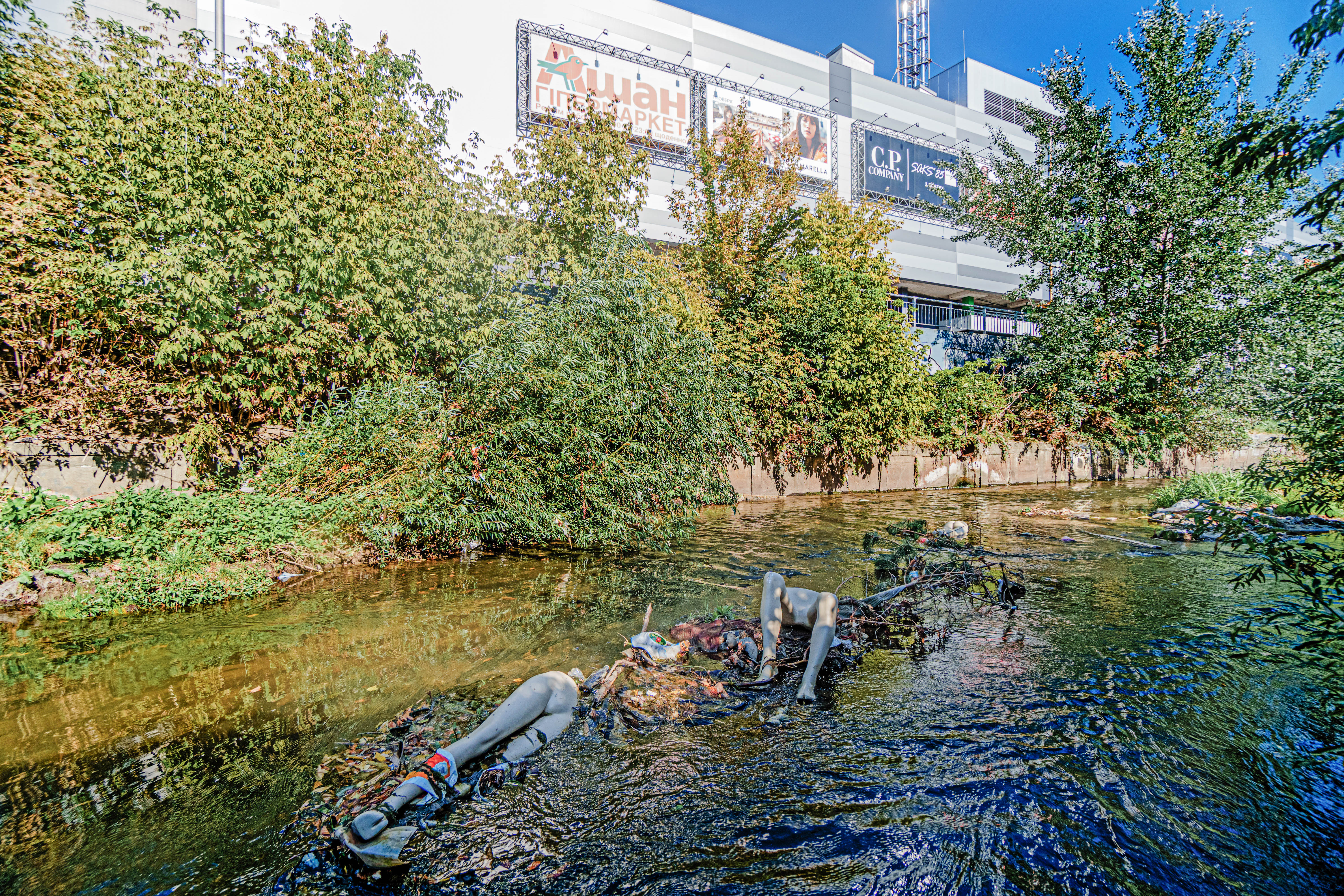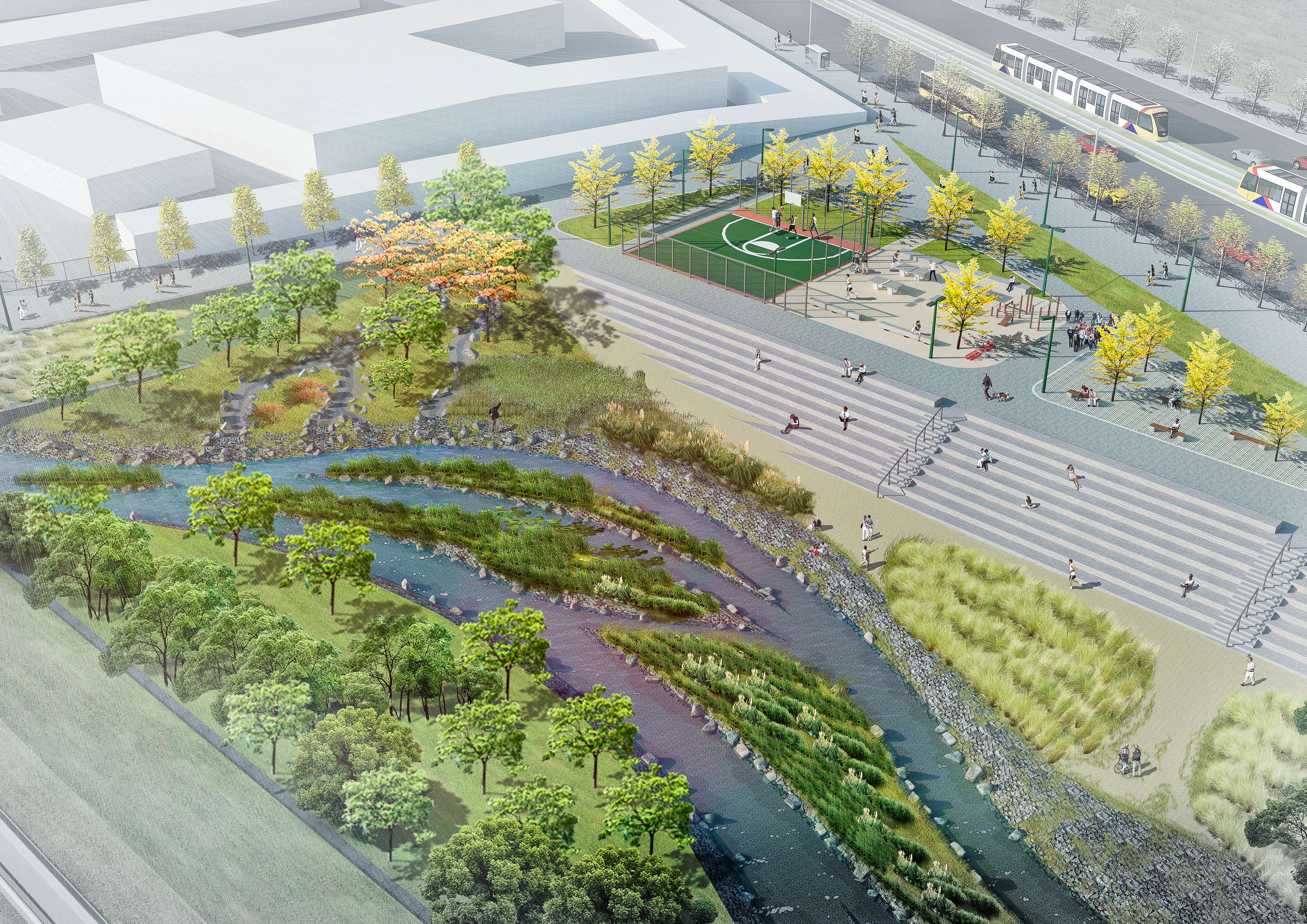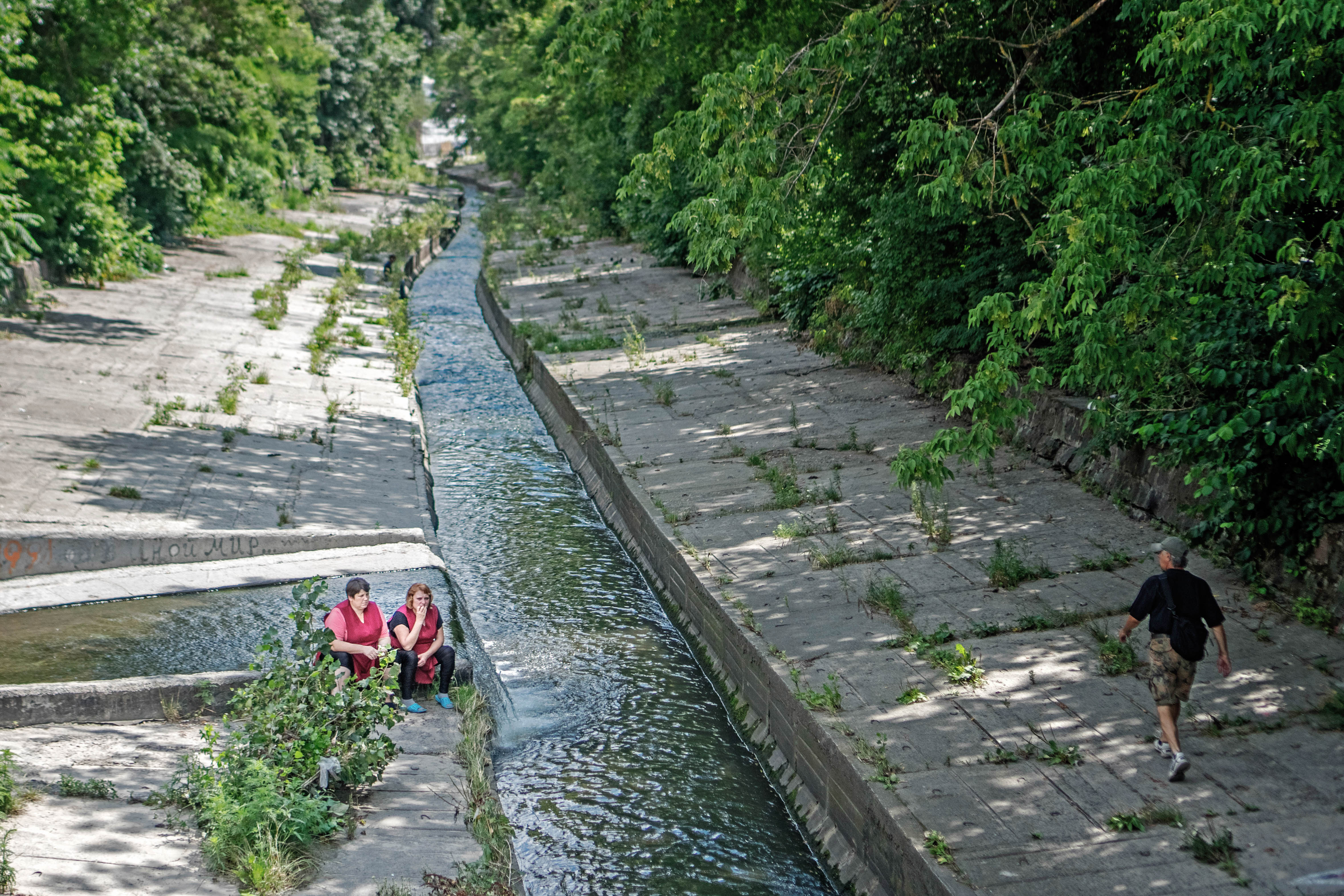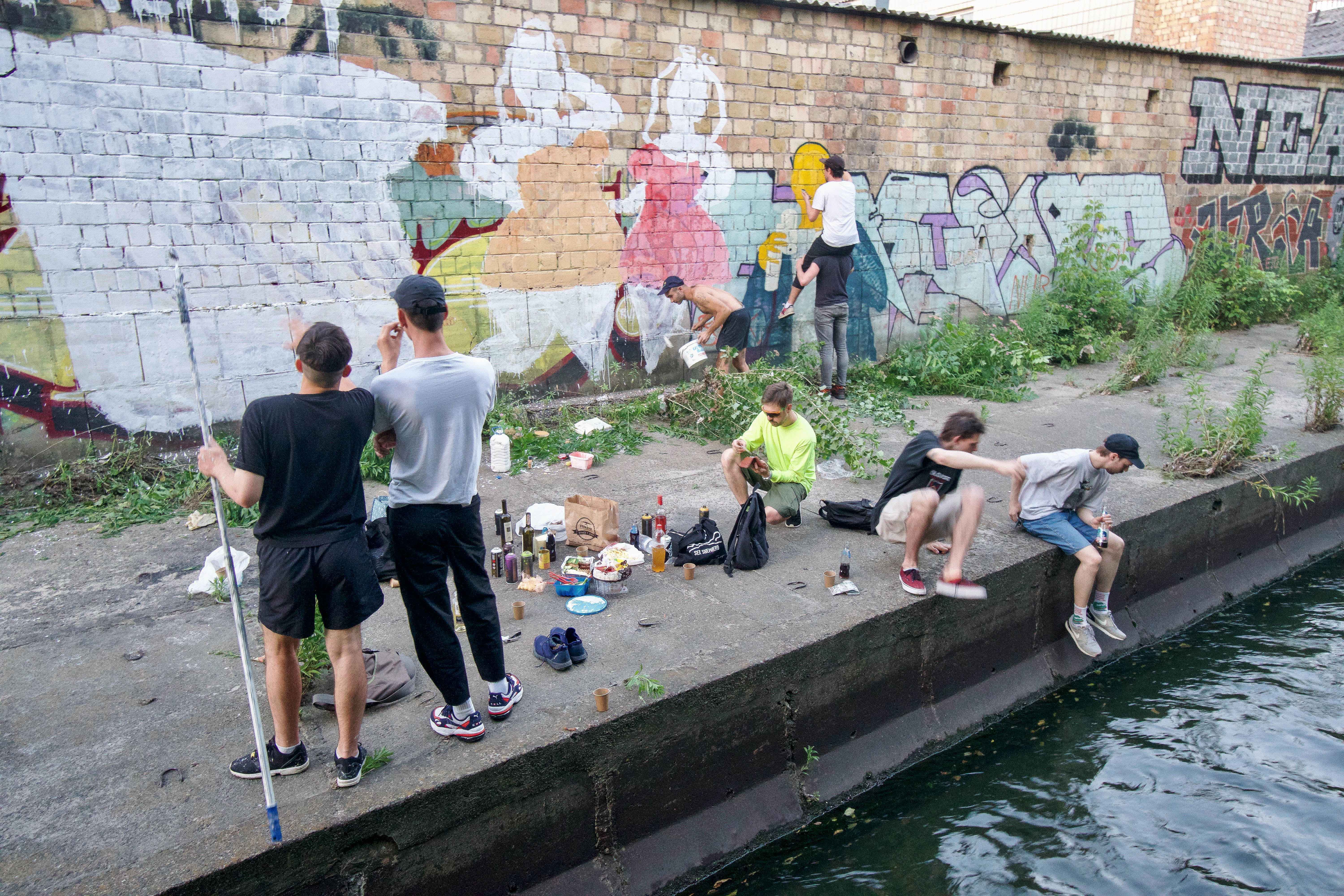It was declared an ecological disaster zone in 2015, following a petition that collected more than 10,000 signatures from Kyiv residents. But now the capital’s legendary Lybid River is at the center of radical plans to rejuvenate the rundown industrial heart of the city.
Over the centuries, the 17-kilometer river has dwindled. It has been forced underground for almost half its length, before becoming a tributary to the Dnipro River. Since 1935, when the Soviets deemed the river as nothing more useful than a drainage canal, it has largely been contained within a narrow concrete channel.
According to folklore, the river was named after the princess called Lybid who, along with her three brothers, founded Kyiv in the 6th century. Legend has it that the river first began flowing from her tears on the day that Lybid realized she would never find her true love.
Now, centuries after trading ships stopped sailing along her course, the Lybid miraculously continues to flow through the heart of Kyiv. But it amounts to a filthy waterway that has become a stain on the reputation of a city awash in hastily built skyscrapers and other giant developments that, at best, pay lip service to the environment.
But could things finally be about to change?
Civic activists have floated an ambitious green vision that could resuscitate the Lybid and regenerate deprived parts of the capital. Conceptual images unveiled by Nasha Lybid (“Our Lybid”), a non-profit organization, show the ecology of the river partially restored and riversides of wooded public parks flanked by residential and mixed-use commercial developments.
The foundation has now begun looking for investors and developers to make that vision a reality.
Speaking to the Kyiv Post beside a new hotel overlooking the river, Nasha Lybid chair Viktor Mashtabei rejected criticism of the plans as unrealistic.
“During a presentation the other day someone told us ‘I expected a project such as this in Dubai, or Abu Dhabi, but Kyiv? Impossible.’ But it is possible,” he beamed.

The torsos of mannequins are seen covered with trash on a stretch of the Lybid next to Ocean Plaza mall on Wednesday August 28 (VINCENT MUNDY)
The long-term plan is a tree-lined corridor to rehabilitate the whole riverside, all the way to the mouth of the Dnipro River. But at the heart of the initial proposals are a glistening glass bridge resembling a necklace of tears and a futuristic riverside cultural center that looks like a beehive eroded by waves.
Such flamboyant public infrastructure won’t come cheap, but the bubbly 75-year-old Mashtabei, who looks two decades younger, is confident as they begin searching for financing. “We estimate the new park — with landscaping and tree planting and including the bridge and culture center — will cost Hr 2 billion ($79 million). Our focus now is on finding investors.”
Standing riverside next to Mashtabei, clutching a large color portfolio of conceptual designs, Nasha Lybid’s lead architect, Alexander Krivenko, reveals some details of the initial works. “We are talking about the territory between Fedorov street and Yamska street, so about one and a half to two kilometers in total.”
Gesturing across the Lybid as a dead cat floats by, Krivenko continues: “Currently, it is a cluttered area with many derelict Soviet-era buildings and piles of garbage. The project involves large scale landscaping, renewing the river bed and creating architecture that inspires Kyiv residents and becomes a safe, green zone for locals, families and tourists.”
Nasha Lybid’s vision has been three years in the works and has an impressive list of supporters. But is it enough?
Kyiv’s chief architect, the Kyiv City Council, the Kyiv City State Administration and several city district authorities have backed the project. But property developers may demand that the generous amount of land currently allocated for public parkland and cultural buildings be reduced.

One vision for the Lybid River in Kyiv imagines the reuse of a plot of city-owned land near Kyiv Polytechnic Institute, a parcel that is currently occupied by dozens of garages, whose owners forced the plan to be scrapped. (Zemlia design studio) (Vincent Mundy)
Mashtabei bats away the suggestion, but there are other concerns, including identifying the ownership of some of the land needed for acquisition. “We have identified the owners of most of the earmarked land and everyone we contacted is cooperative, but there are still some unknowns,” Mashtabei admits.
Undeterred by the complexities and scale of the challenge, Madhtabei says he hopes the scheme will be a model for other Ukrainian cities to use their own derelict and polluted waterways as a focal point for green urban regeneration.
“If our plans for the Lybid are successful, it could have a ripple effect across our country, and that’s important, because we have many rivers in the same condition,” Mashtabei says. “So we hope to inspire other projects as ambitious as ours.”
How feasible the plans are remains to be seen. But if the experience of Kyiv architect and civil society activist Semen Polomanyi is anything to go by, then Nasha Lybid’s vision may struggle to be realized.
Speaking to the Kyiv Post in the office of Zemlia, his design studio just a short walk from where the Lybid first emerges, Polomanyi praises the “utopian vision” of the project, but voices a note of caution.
After his own Lybid revival scheme recently got nixed, he is skeptical that the local authorities will maintain support for Nasha Lybid’s plans. He also is unsure whether suitable developers can be found.
“After a couple of years of serious planning and hard work, we realized that perhaps Kyiv isn’t ready for the kind of environmentally friendly urban regeneration we devised and that you might see in Western European capitals,” Polomanyi says.
Two years ago, his design firm and other partnering architects submitted more modest proposals that would have rewilded a section of the river and transformed a triangular wedge of riverside property near Kyiv Polytechnic Institute (KPI) into a green urban park alongside a nearby eco-friendly, mixed-use riverside development. But the city council-owned land is occupied by an influential community of garage owners who would need to be evicted for the plans to be implemented.
Despite winning grants and several design awards for their plans and the support of some city officials, the scheme was apparently shelved in the face of vocal opposition from the garage owners.
“We submitted detailed plans for the site and we thought it was going somewhere but we never heard anything back from the authorities,” says Polomanyi. His team also tried to work with developers working nearby, but with no result.
Lybid Ye, a civil society organization co-founded by Polomanyi, and other similar associations have raised awareness of the Lybid’s plight. They set up a popular Facebook page, took donations and, with the help of many volunteers, organized Lybid clean-up days and arts and cultural events. In one spot, they even managed to install timber benches with stepped wooden seating areas. But it wasn’t long before the new infrastructure was vandalized and damaged.

Locals relax by the river Lybid in Kyiv in this file photo from 2018 (VINCENT MUNDY)
Even at this small-scale, efforts to improve the Lybid faced major obstacles, says Oleksandra Vdovychenko, founder of the Lybid 7 Initiative, which also took part in the efforts.
“The locals are afraid to go there and it has become a place for homeless people, alcoholics and drug addicts,” Vdovychenko complains. “In addition to sewage and garbage, there is no interest from the city administration. The mayor and council officials don’t seem to care about what is happening to the water and the banks of the river.”
Kyiv Mayor Vitali Klitschko directed questions about the Lybid to Petro Panteleev, deputy head of the Kyiv City State Administration. Panteleev responded in writing that “the municipality is spending Hr 20 million ($791,000) this year to renovate the river bed completely. The project includes the reconstruction of hydraulic structures, the strengthening of the shore, the creation of a public space for recreation… and the improvement of its coastal protection strips.”
Other local officials say improving the Lybid must be part of a broader strategy to protect and restore Kyiv’s natural environment. Serhiy Gusovsky, a restaurateur and Kyiv City Council member, says he would put forth more efforts to improve the Lybid and other endangered natural and historical sites if he were the mayor.
“Of course I want to see the Lybid restored. It is a river of great cultural and historical importance to Kyiv, but to tackle this issue we need a holistic new strategy,” he says. “The current mayor has tried his best, but the current city plans are more than 20 years out-of-date and this is holding us back.”
“What we need is a completely new and fresh vision for revitalizing the whole city, not only the Lybid,” Gusovsky adds.

Street artists gather to paint a section of wall facing the Lybid River on June 11 2019 (VINCENT MUNDY)
History of neglect
But while visions and promises for the Lybid are not in short supply, the river’s recent history is one of neglect and missed opportunity.
The brash $300-million Ocean Plaza mall, completed in 2012, was built on the banks of the river next to Lybidska metro station. But although no efforts were made to consider the Lybid River in the mall’s plans, the development was nevertheless approved by city authorities.
Ukrainian Development Partners (UDP Group) and KAN Development — a company partly owned by Klitschko — along with their Russian partners did, however, decide to build a gigantic saltwater aquarium housing sharks in the middle of the huge shopping and entertainment center.
Just a few meters away from the shoppers and the sharks, the hulking backside of the mall casts a long shadow over the Lybid. A drunk man urinates over the river bushes and a brave family of mallard ducks forages for food among a never-ending stream of plastic waste floating slowly downstream.
Along the river’s edge, countless multicolored shreds of plastic drape from the hardy willow trees that have forced their way through cracks along the greasy concrete riverbank. Plump rats gorge themselves in heaving waste bins and scamper around the mounds of rotting detritus left by the mall’s hundreds of shops, multiplex cinema and fast food outlets.
But even now a few small fish can be seen darting under the river’s oily river surface. Many homeless people have also found refuge here, living under the bridges beside the city’s huge thermal heating pipes which line long stretches of the Lybid.
One of them, who only gave the name Vitalik, said that he is not expecting much from the city.
“I’ve lived on the Lybid for years, and you might think down and out here I don’t know what’s going on,” he said with a smile. “But I’ve heard all the Lybid plans. They always make promises, but nothing ever happens.
